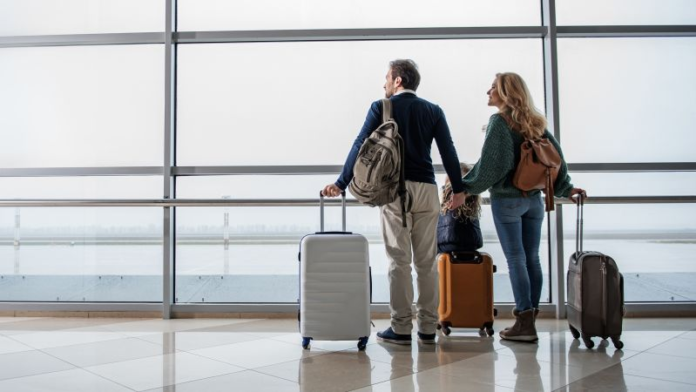Editor’s Note: Dana Santas, known as the “Mobility Maker,” is a certified strength and conditioning specialist and mind-body coach in professional sports, and is the author of “Practical Solutions for Back Pain Relief.”
CNN —
For many people, travel is a necessary part of celebrating the holidays with loved ones. This means enduring all the stressful hiccups that can come with traveling and spending time away from the comforts of your own home.
Every year, my family kicks off the season by watching the classic comedy “Planes, Trains and Automobiles,” starring Steve Martin and the late John Candy. In it, the two men are strangers who end up stuck together, dealing with a comically inordinate number of travel-related issues while trying to get home for Thanksgiving.
There’s a good chance your holiday travel won’t get as complicated as Martin’s and Candy’s, but you may face delays, diversions and many hours of sitting that can take a toll on you mentally and physically. So, whether you’re driving to Grandma’s for Thanksgiving or flying to see family in another country, try the five tips below to reduce stress and tension so you can enjoy the holidays.
Take control of your posture and breathing
When you sit for long periods while traveling, your posture often suffers. Given the intimate relationship of your breathing pattern and your posture, slumping while seated leads to shallow, rapid breathing, which incites your body’s stress response. It’s a vicious cycle that increases physical and mental tension.
That’s why it’s important to take control of your breathing at least once an hour while traveling to help restore your posture and cultivate a sense of calm. Taking just five or six long, deep breaths while focusing on getting your low ribs to move as demonstrated in this video can make a big difference!
Video Ad Feedback Optimize your breathing with these tips 03:08 – Source: CNN
Just 90 seconds of deep breathing elicits a relaxation response that decreases your heart rate, blood pressure and stress hormone production, according to research.
Drink enough nonalcoholic fluids
Those muscle cramps and achy joints you experience on the road may have a lot to do with your fluid intake. Considering that our bodies are mostly water, hydration is important for proper joint lubrication and circulation. But your hydration level doesn’t just affect you physically. When you’re dehydrated, it increases your body’s cortisol (primary stress hormone) levels, which can lead to feelings of anxiety, exhaustion and overall irritability.
Holiday travel can cause tension, but you can ease stress with strategies like mindful breathing and walking breaks. Adobe Stock
Your access to drinking water may be limited while traveling, so it’s important to plan ahead. You can’t bring bottled water through Transportation Security Administration checkpoints, and no one likes to pay the exorbitant prices for bottles of water at the airport. Thankfully, most airports have filtered water stations to refill bottles for free. So pack a reusable water bottle and, if you’re driving, don’t forget to bring a cooler with water.
Even when you aren’t traveling, the holidays make it easy to become dehydrated. With all the festivities, we often forget to drink as much water as normal, especially when cocktails are flowing. But alcoholic beverages are no substitute for water because they’re dehydrating.
Alcohol suppresses natural production of the antidiuretic hormone vasopressin, which keeps us from urinating too much. Without it, we find ourselves in the bathroom more often. Counter the dehydrating impact of alcohol by drinking one glass of water for every cocktail.
Stand and walk every opportunity you can
Studies abound regarding the health dangers of prolonged sitting, yet few people seem to make an effort to avoid it while traveling. Looking around the airport, you’ll find most everyone sitting at the gate waiting to get on their plane, where they will inevitably remain seated for at least a couple of hours or more.
Break up bouts of sitting by taking advantage of opportunities to stand and walk around whenever possible. At the airport, take a walk around your terminal. Some airports even have yoga rooms with public access. When traveling by car, find a park or even a mall on your route where you can get out and take a 10-minute walk.
Stretch out the tension
Lots of sitting during travel also means compressed side waist muscles, overused hip flexors and tight low-back muscles. If you want to be more comfortable and avoid pain when traveling, you need to stretch out those muscles whenever possible.
My go-to travel stretch is the warrior hip flexor release.
Dana Santas demonstrates the warrior hip flexor release. Courtesy Dana Santas
Here’s how to do it:
Stand to the right of a wall, chair or other stable surface. Place your left hand on it for support.
Step your right foot back into a short lunge position, dropping your back heel and pointing your toes out slightly, as shown.
Bend your front knee to align above your ankle, while your back leg remains straight.
Inhale as you lift your right arm up and over your head.
Exhale as you side bend to the left, feeling your left lower ribs rotate inward.
Avoid arching your lower back.
Hold for three long, deep breaths. Repeat on the other side.
Check out the video at the top of this story for more exercises to combat the negative impact of sitting.
Take recovery seriously
You might be so relieved to get to your destination that you think plopping down in a comfy chair is all you need. But it’s even more beneficial to get your legs up above your heart, which promotes venous blood flow and helps reduce lower-body swelling.
The yoga pose known as
5 tips for taming travel tension over the holidays
RELATED ARTICLES




